Fiido Nomads Review | Your Cycling Endurance Booster
A more realistic bike riding experience. A solid and versatile platform with fitness and endurance benefits for those simply looking to take longer rides than they’re able to on non-motorized ones.
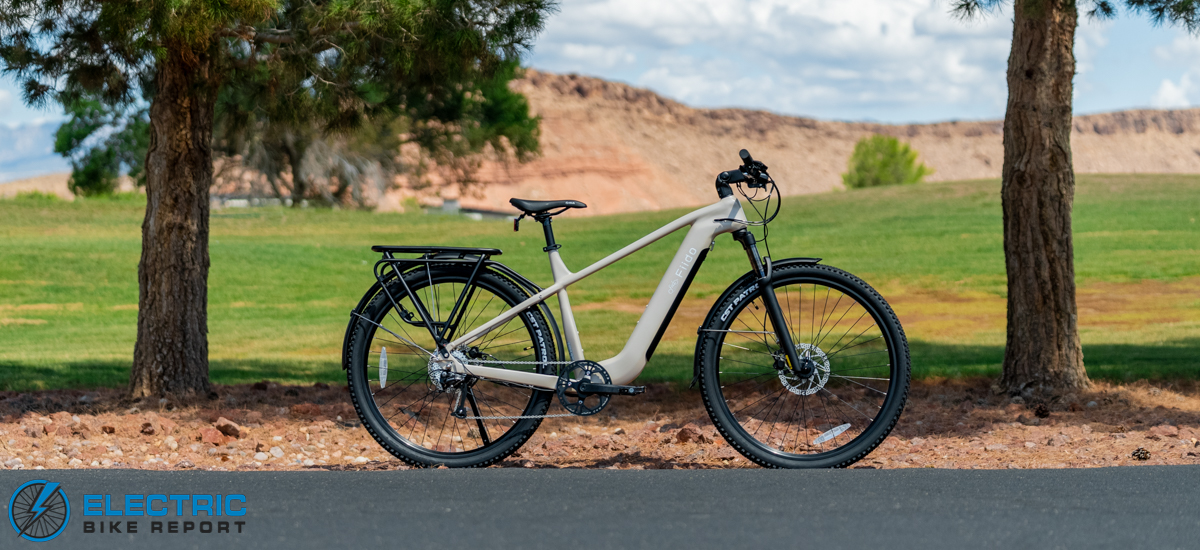
Many e-bikes advertise raw speed and brute power, but what often gets overlooked is how well they can extend a cyclist’s own effort. The Fiido Nomads leans into that strength. Instead of trying to feel like a motorbike, it provides a ride experience that’s closer to your current acoustic bike, just easier, fresher, and longer lasting, and making hills far less daunting of a task.
With its modest 250W motor, lower top speed, and efficient use of battery power, the Nomads emphasizes endurance over pure adrenaline. Riders who want to push their cardiovascular efforts a little further, or cover ground they couldn’t before, will find it an appealing option. Add in hybrid tires for mixed terrain, a 120mm suspension fork, and a wide 9-speed gear range, and you get a bike built for comfort across a variety of settings.
Fiido also takes its trekking potential seriously: the Nomads can run up to three batteries (two rack-mounted spares, plus the main frame unit) without sacrificing cargo space. That flexibility, paired with multiple frame sizes and an adjustable stem, makes it a surprisingly adaptable and affordable endurance-focused e-bike. While a U.S.-specific version with higher speeds would unlock broader audience appeal, the Nomads still shines as a natural-feeling, go-farther machine for commuters, trekkers, and casual cyclists alike.
 Pros
Pros- Natural feel/ride experience. The hub motor and torque sensor combine for a very smooth engagement.
- Versatile bike. It is a capable commuter (rack, fenders, lights, and turn signals), but has a rugged side for trekking with a 120mm fork and hybrid, knobby tires.
- Affordability. Pricing is entry-level, while quality is a step above. Some nicer components and a sleeker appearance boost the value considerably.
- Nice fit adjustments. Two frame sizes and an adjustable stem help find an ideal fit.
- Huge range potential. The single battery had a highly efficient range, but for $600 more, you can triple the capacity with an expanded rack that houses two more spare batteries.
 Cons
Cons- Lower speed cap. The bike works well if you just want a boost and typical casual bike speeds, but it’s 15 mph speed limit is under the 20 mph mark of most US bikes.
- The display works nicely, but you can’t adjust the angle. It’s slightly problematic if you adjust the stem to make the handlebars more upright.
- Battery: 418Wh
- Charger: 36V 2A
- Display: LCD 1.47 inch
- Motor: 250W Permanent Magnet Brushless Geared Motor, 45Nm torque
- Headlight: dual LED
- Taillights:included in chainstays, turn signal functionality
- Pedal Assist: Torque sensor (Mivice S200)
- Claimed Range: Up to 49.30 miles
- Throttle:No
- App:Fiido
- UL Certification:
- Claimed weight: 54.5lbs
- Tested Weight: 55 lbs
- Rider height range: 5’5” – 6’9”
- Total payload capacity: 265 lbs
- Brakes:TEKTRO HD-M275 hydraulic disc brake
- Fenders:Plastic
- Fork:Front Suspension: Oil-Spring, 120mm Travel
- Frame: Aluminum
- Drivetrain: SHIMANO M370, Altus derailleur, 9-Speed 11-32T, 44t chainring
- Grips: TPR non-slip grip (length: about 130mm)
- Saddle: VELO vacuum full lamination
- Handlebar: Aluminum alloy rose handlebar, length: 720mm; maximum diameter: 31.8mm; minimum diameter: 22.2mm
- Kickstand: included
- Pedals: Metal, included
- Tires: CST 29*2.1″ inch
- Rack: Included, 59 lbs capacity

With the adjustable stem, you can change up the feel to be sportier or more relaxed.
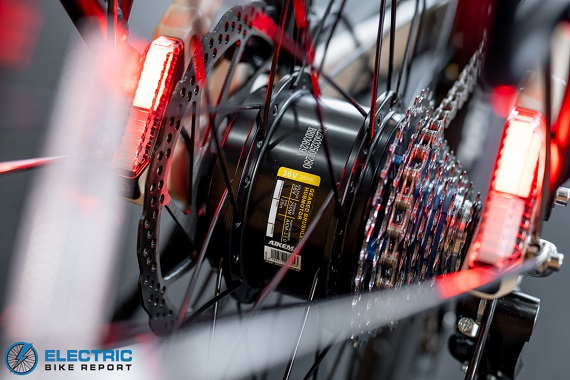
36v, 250W hub motor isn’t too common stateside, but they produce a superbly natural feel, and can punch above its weight class on hills.

The battery tucks away under the frame and has two latches for redundancy, which keep it in place.
Fiido Nomads Review: Speed Test
Let’s address the elephant in the room: the Nomads doesn’t reach 20 mph. Its top speed is 15.5 mph, which matches the 25 km/h limit in Europe, where Fiido also distributes. I’d love to see a U.S. version that unlocks 20 mph, but for now, it’s worth looking at what this bike offers within its current setup.
With a torque sensor for natural engagement and a 250W hub motor, the Nomads does a respectable job of mimicking a traditional ride feel, only easier. Here’s how our speed test shook out:
- No motor: 9.9 mph
- Eco: 12.2 mph
- Normal: 12.8 mph
- Sport: 14.8 mph
- Turbo: 15 mph
- Turbo +: 15 mph
In practice, the motor can hit 15 mph in any mode, but these results show where it lands with modest pedaling effort.
A few takeaways stood out. First, five PAS levels felt excessive, given a 15 mph top speed; three levels make more sense. Fortunately, the Fiido app lets you adjust to a simple low/medium/high setup, which I’d recommend.
Second, the ride feel is more natural than most hub drives at this price. It’s not just because of the modest power output; there’s genuine fine-tuning here that I usually don’t see unless at a higher price tier.
Where the speed really shines is in comparison to a traditional bike commute. If you’re used to pedaling an analog bike, the Nomads will feel familiar, only you’ll get there with less sweat and a little more ease, especially on hills. For commuting, that means slightly quicker ride times and showing up fresher. For trekking or touring, it translates to longer, more enjoyable outings where you still get a workout but significantly extend your range.
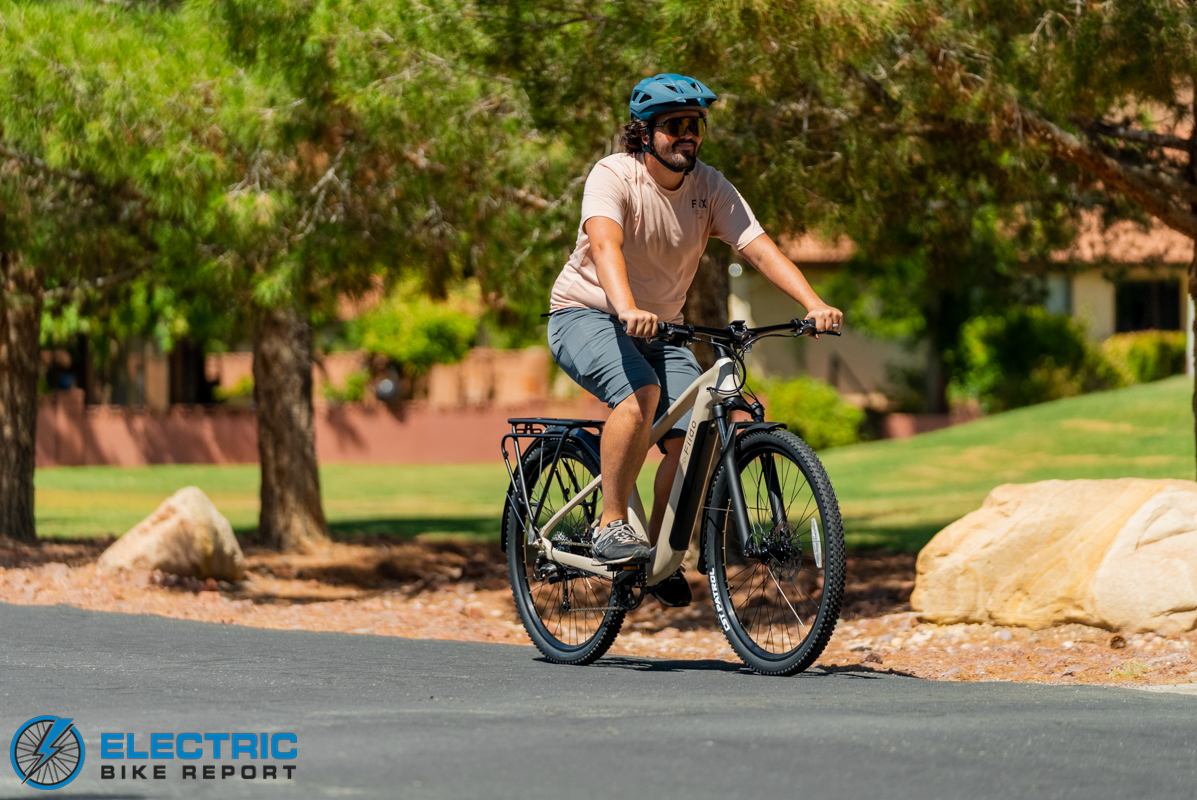
The Nomads has nice middle-of-the-road handling.
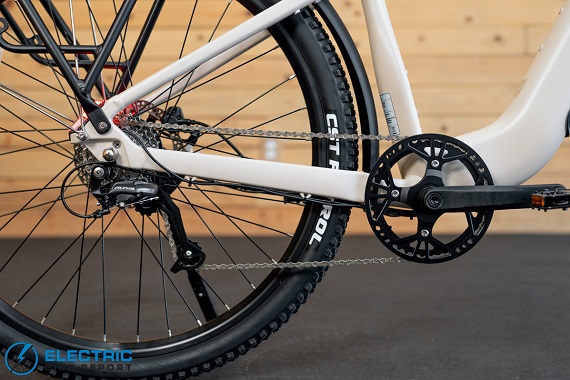
Adequate gear range for all sorts of riding scenarios.

The display is fixed in the stem, and the tilt angle is, unfortunately, tied in to how you set up the handlebars. It would be nice to adjust it independently.
Fiido Nomads Review: Range Test
A 418 Wh battery paired with a 250W nominal motor has impressive range potential. That’s nearly a 2:1 ratio of battery to motor wattage, which is far more generous than the 1:1 setups we typically see. Fiido also does its own internal testing, reporting 49.3 miles in Eco mode and 36.5 miles in Turbo with a 187-lb rider on mostly flat terrain.
Surprisingly, our team was able to surpass those numbers on a mixed trail system with both flats and hills. We achieved 63.2 miles on Eco power, and 34.3 on Turbo. That’s not something we usually see, but it’s the kind of surprise we’ll take any day.
Looking at efficiency, the Nomads was nearly off the charts compared to other commuter bikes in our database. To be fair, most commuter e-bikes can go faster, which naturally requires more power. On average, commuters use around 11.4 Wh/mi in low PAS settings and 21.6 Wh/mi in high power. The Nomads only used 6.6 Wh/mi and 12.2 Wh/mi, respectively. Those are some of the best numbers we’ve recorded, and easily the most efficient hub drive result we’ve ever tested.
The takeaway is simple: this bike doesn’t necessarily make you lightning fast on flats, but it absolutely conserves your energy while still providing you an uptick in speed, and becomes a difference-maker on hills. That’s what allows riders to extend their commutes or explore further without burning out.
And if you really want to push the limits, Fiido sells a range-extender setup that adds two additional batteries and the rack attachments to bring them along. I like how even with those attached, the rack still leaves room for panniers and top storage. At just $600, it’s a solid value for another 836Wh. You have to swap the batteries, but you also get protective sleeves to protect it from the elements.
According to our data, you would be looking at around 102 – 189 miles of range total. That’s plenty for touring adventures.
Fiido Nomads Review: Hill Test
We put the Nomads on our go-to test climb, the Devil’s Backbone. It’s a half-mile stretch with a punishing 8% average grade. It’s the benchmark we use to see just how much hill help a motor can provide.
Performance went about as expected for a 250W hub motor with 45Nm of torque: slower to the top, but smooth and natural in how it delivered power. The Nomads completed the climb in 2:54 at an average of 10.8 mph. For context, the current all-bike average is 2:06, and the commuter category average is 2:17.
Here’s where things got interesting: despite its modest motor, the Nomads wasn’t the slowest hub drive we’ve tested, and even with a speed handicap that other bikes didn’t have, it still outpaced other hub motors we’ve tested this year. In fact, it outperformed six other hub motors with higher wattage and torque. How? A wide gear range and efficient cadence helped here, as did its narrower tires, which avoided the drag we sometimes find on other commuters. Its 55 lbs of weight isn’t ultra light, but firmly on the lighter side nonetheless, which also contributed.
This test further supported the bike’s overall theme: while most riders on acoustic bikes would walk this climb, the Nomads make it not only achievable but also enjoyable, without sacrificing that authentic cycling feel.
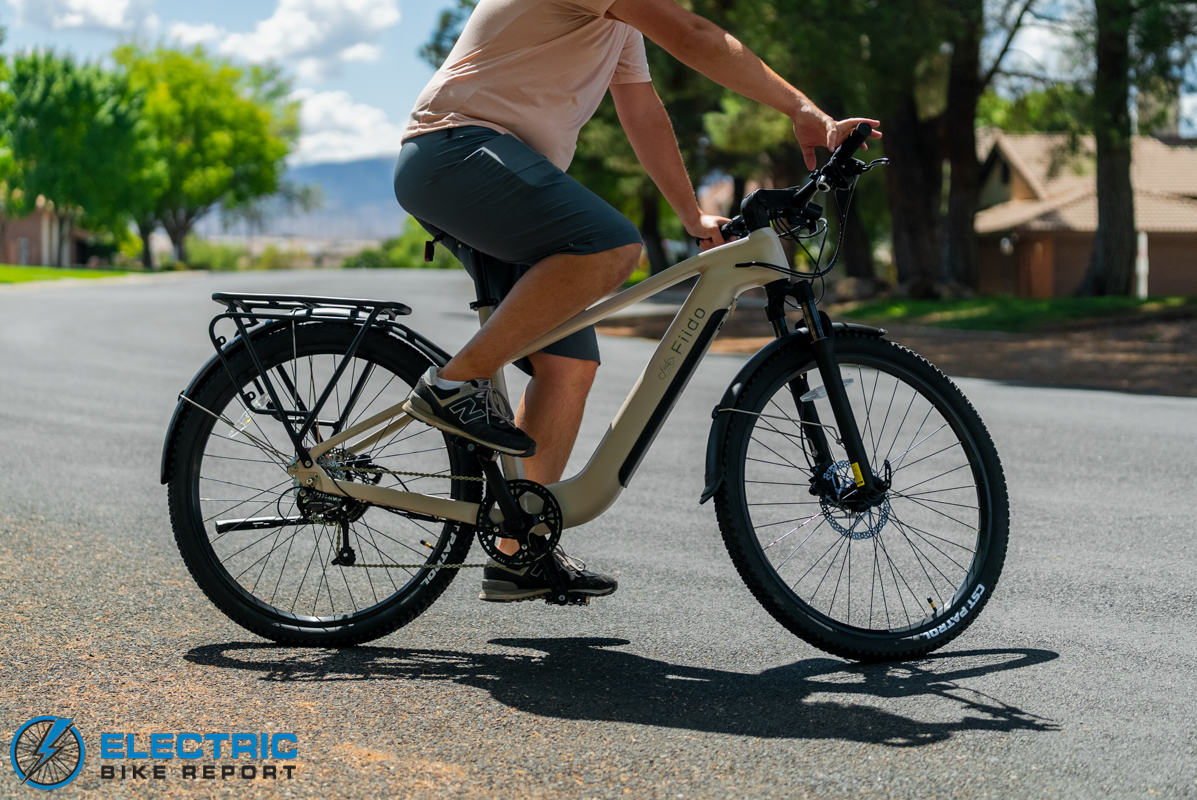
Arguably, the two best qualities about the Nomads: It’s an affordable ride, but it rides like something a tier above its price.

We largely think of 2-piston hydraulics as the e-bike standard, so it’s good to see Fiido didn’t skimp here.

120mm of travel on the fork is more than your average commuter. It did sag under my 230 lbs weight, but didn’t feel too floppy, and it didn’t readily bottom out either. It’s a decent fork for the price.
Fiido Nomads Review: Brake Test

The Fiido Nomads comes equipped with Tektro HD-M275 hydraulic brakes: a 2-piston setup paired with 180mm rotors front and rear. While this is considered entry-level in the eMTB world, it’s still a step above what most commuter e-bikes typically receive.
In our brake test, the Nomads stopped in 24’4” from 20 mph. For comparison, the current all-bike average is 21’11”, and the commuter category average is 22’4”. So the Nomads came in a touch longer than expected, but still within a safe margin. Importantly, it stayed within our 25’ mark which we consider the safety limit.
The brakes themselves felt fine; the levers were easy to operate, with good modulation and no complaints regarding control. The longer distance likely comes down to the tires.
Our database primarily features bikes with 20”–27.5” tires, and smaller diameters typically have shorter stopping distances. At 29”, the Nomads’ wheels are larger than most in this test. Additionally, the hybrid tread is designed for mixed terrain, providing great traction on loose surfaces. However, with a smaller road contact patch than a slicker commuter tire, braking power is naturally reduced.
All things considered, the setup works well for the Nomads’ intended purpose. It’s confidence-inspiring enough for urban commuting and versatile enough for light off-road use. As a bonus, Fiido even included integrated brake lights. It’s a thoughtful safety touch on a bike at this price point where that’s not a given.

Continuing the theme of nicer quality, the dual LED headlight is impressively bright, and the braided cables that run through the frame clean up the look.
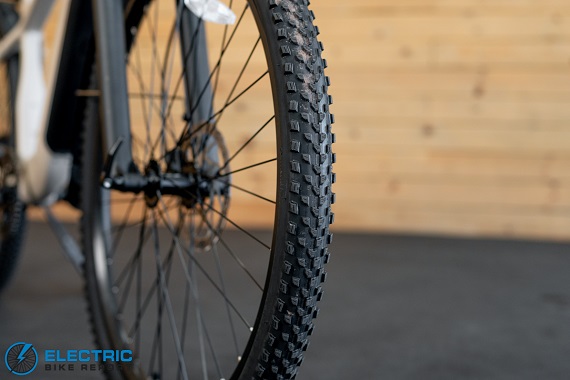
I liked the tire choice. It’s narrow enough to feel quick and efficient, but there’s enough tread for help on looser surfaces.
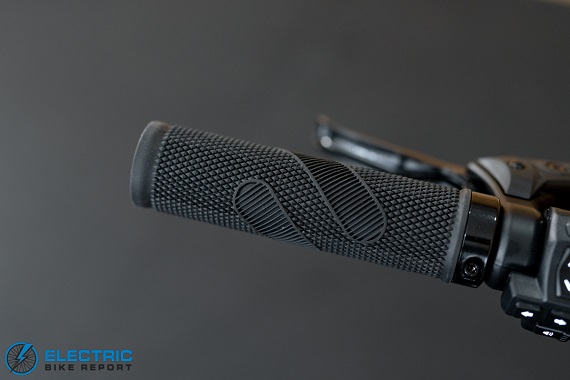
Tacky and textured grips make it easier to hang on over rougher roads.

The adjustable stem helps dial in the fit, and I felt confident even at higher speeds (where cheaper ones can feel unsettled).
Fiido Nomads Review: Ride Quality
With the Nomads, Fiido clearly aimed to keep pricing affordable. The smaller motor and battery help keep costs down, but Fiido seems to have reinvested those savings into nicer components and thoughtful features. The result is a bike that rides surprisingly well for its entry-level price tag.
Starting with the frame: it’s available in just one color but comes in two sizes, with an adjustable stem to fine-tune reach. You can set it up for a more aggressive fit or an upright, relaxed posture. The stem feels solid—not flimsy—and it neatly forks around the display.
One downside is that the display tilt can’t be independently adjusted since it follows the stem’s angle. On the upside, the bike uses a color display with a higher-than-average IP68 rating, making it durable and easy to read at a glance. Win-some, lose-some.
Aesthetically, the Nomads looks clean, thanks to braided cabling and internal routing. The removable main battery is double-latched for security and balances weight distribution well with the small rear hub motor. At 55 lbs, the bike feels evenly distributed and stable at speed or when leaning into turns. The 720mm handlebars are a little narrower than I personally prefer, but handling sits comfortably in the middle ground—neither overly sharp nor sluggish.
Fiido also included a full commuter kit: headlight, fenders, rear rack, brake lights, turn signals, and even an electronic horn. The only real drawback is the lack of a timer on the turn signals, where I found myself “indicating left” for far too long after forgetting to switch them off.
On the rugged side, the bike features a coil suspension fork with 120mm of travel. It’s unbranded, so long-term durability is a question, but it feels standard for this level. Preload adjustment helps, though at my 230 lbs I did notice some sag on mounting. Still, plenty of travel remained for bumps, potholes, and light gravel chatter. The 29” x 2.1” CST hybrid tires also add versatility: their semi-slick pattern rolls efficiently on pavement while providing enough bite for hardpack or loose surfaces. The larger wheel size enhances ground clearance, which is particularly useful for navigating roots or rougher terrain during camping or trekking rides.
Fiido also offers an app. It’s not essential, but it adds some features: a rider leaderboard, bike locking via password, and even smartwatch pairing (which we didn’t test) for auto-unlock functionality. I mostly used it to reduce PAS levels from five to three for a simpler low/medium/high setup. The app also supports firmware updates, which makes me hopeful Fiido could enable higher speed settings for the U.S. market down the road (but I’m not making any promises on their behalf, its just my personal wish list item).

The included rear rack features a 59 lbs weight capacity, and you can secure the two spare batteries to the sides, leaving room for panniers.

A nice and supportive sports saddle.
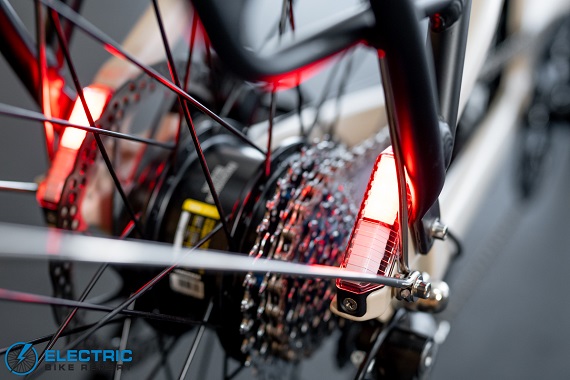
The taillights were very bright, and they had turn signals. They’re also positioned where they should still show through under pannier bags.

I wouldn’t have minded a slightly wider handlebar than the 720mm, but it still contributed to the nice-feeling handling.
Fiido Nomads Review: Summary / Where to Buy
The Fiido Nomads is a solid commuter with touring potential at a price that’s easy to appreciate. Fiido includes some thoughtful touches—like a wider gear range, quality hybrid tires, and a fork with more travel than usual—while also delivering a polished look and the full commuter kit of lights, rack, fenders, and turn signals. Add in multiple frame sizes and an adjustable stem, and it fits a wider range of riders than most budget e-bikes.
European riders, in particular, will find a lot to love here. The 250W motor engages smoothly with pedal input, creating an affordable, capable ride that feels natural. For U.S. buyers, the 15.5 mph speed cap is the one limiting factor. It’s the only thing that really narrows its appeal.
That said, the Nomads still serves a very real audience. Many commuters and recreational cyclists tell us the reason they haven’t gone electric is that they don’t want to “cheat,” meaning they enjoy the cardio that comes with riding. The Nomads speaks directly to that crowd. It matches the speeds most casual riders already reach but makes the experience easier: hills become manageable, rides last longer, and with the optional triple-battery setup, epic journeys become possible.
True to its name, the Nomads is built for wandering. It’s versatile, flexible, and efficient—equally ready for daily commutes or extended adventures.
Happy Riding! Make sure to let us know if you have any questions or if you think we left anything out in this review of the Fiido Nomads down in our comments section.



